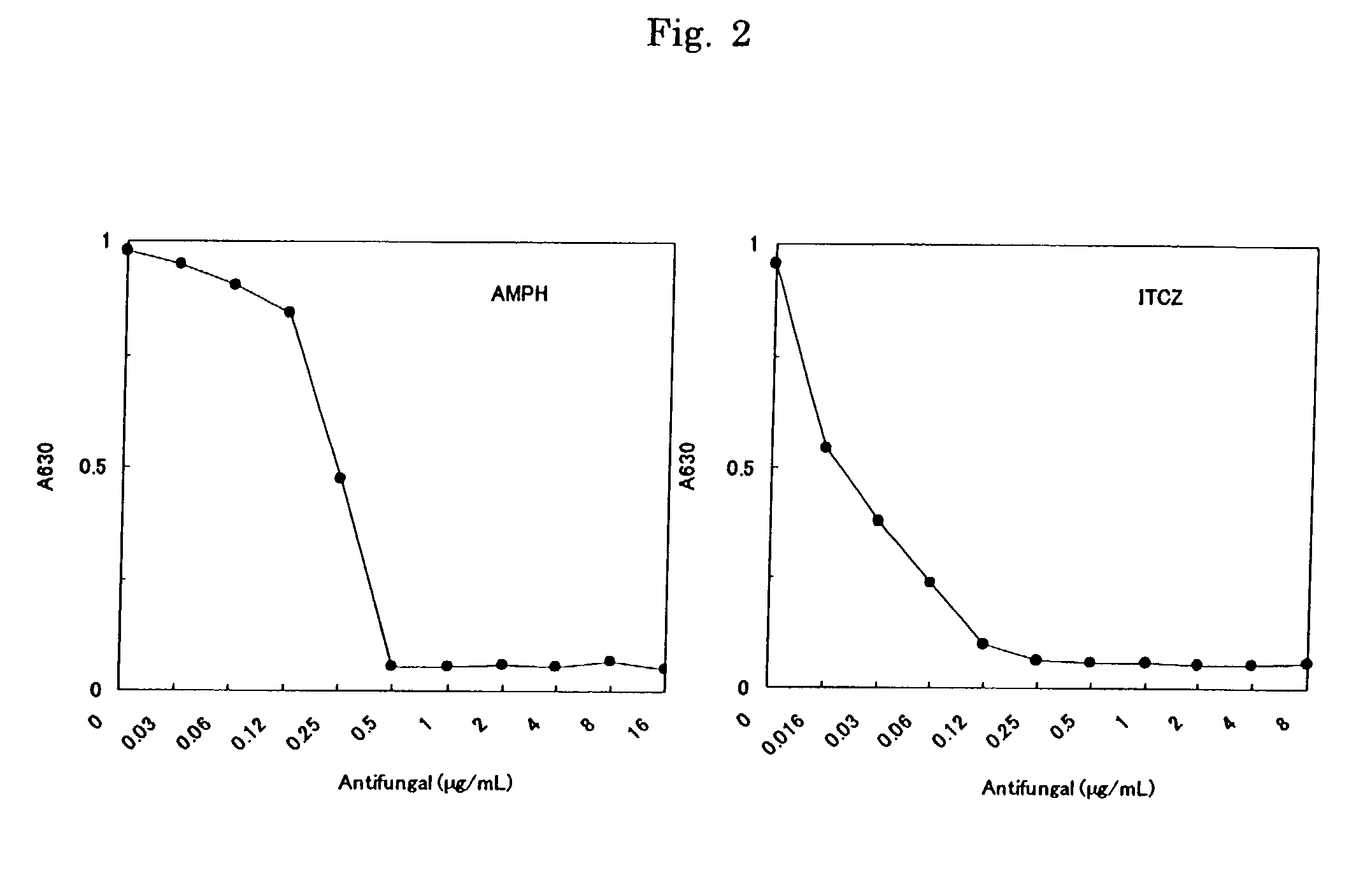Method for detecting microorganisms and detection kit
a microorganism and detection kit technology, applied in microorganism testing/measurement, biochemistry apparatus and processes, enzymes, etc., can solve the problems of inability to carry out precise measurement, inconvenient fungi detection, and long test time, so as to achieve simple and precise detection of microorganisms, the effect of extreme sensitivity
- Summary
- Abstract
- Description
- Claims
- Application Information
AI Technical Summary
Benefits of technology
Problems solved by technology
Method used
Image
Examples
example 1
[0045]In order to select a growth culture medium the following procedures were carried out.
A. Strain Used
[0046]Aspergillus Fumigatus KM8001 was used.
B. Test Method
(1) Preparation of Culture Medium
1) MOPS Buffered RPMI 1640 Culture Medium Supplemented with Added Glucose
[0047]10.4 g of RPMI 1640 culture medium powder (containing L-glutamine, no sodium hydrogen carbonate, and no Phenol Red, manufactured by Gibco), 2.0 g of sodium hydrogen carbonate, 10.0 g of glucose, and 34.53 g of 3-morpholinopropanesulfonic acid (MOPS) were dissolved in 900 mL of purified water, and the pH was adjusted to 7.0 with a 1N aqueous solution of sodium hydroxide. The solution was made up to 1000 mL and then filtered using a 0.2 μm filter.
2) Preparation of Glucose YN Broth
[0048]6.7 g of YN Base (manufactured by Difco) and 5 g of glucose were dissolved in about 900 mL of purified water, and the pH was adjusted to 5.3 with a 1N aqueous solution of sodium hydroxide. The solution was made up to 1000 mL with pur...
example 2
[0054]In order to measure the degree of proliferation of a filamentous fungus the following procedures were carried out.
A. Strains Used
[0055]Aspergillus Fumigatus ATCC26430, Aspergillus Fumigatus KM8001, and Aspergillus niger ATCC16404 were used.
B. Test Method
(1) Preparation of Sucrose YN Broth
[0056]6.7 g of YN Base (manufactured by Difco) and 20 g of sucrose were dissolved in about 900 mL of purified water, and the pH was adjusted to 7.0 with a 1N aqueous solution of sodium hydroxide. The solution was made up to 1000 mL with purified water and then filter sterilized using a 0.2 μm filter.
(2) Preparation of Inoculum and Culturing
[0057]A tester strain was cultured using Sabouraud Dextrose Agar (manufactured by OXOID) at 35° C. for 7 days. 2 mL of sterile physiological saline containing 0.1% Tween 80 was added dropwise onto the culture medium so as to float spores. The above-mentioned physiological saline that had been added dropwise onto the culture medium was recovered and allowed t...
example 3
[0062]In order to examine the applicability to antifungal drug susceptibility testing the following procedures were carried out.
A. Strain Used
[0063]Aspergillus Fumigatus ATCC26430 was used.
B. Microplate Used for Test
[0064]Two drugs, Amphotericin B (AMPH) and Itraconazole (ITCZ) were examined. 2-fold dilution series of AMPH (0.3 to 160 μg / mL) and ITCZ (0.16 to 80 μg / mL) were prepared using dimethyl sulfoxide and purified water. The drug solutions so prepared were pipetted into a plate at 0.02 mL / well and dried to a solid under reduced pressure for 24 hours. A coloring reagent (containing 0.7 mmol / L WST-8, 0.0035 mmol / L 1-methoxy PMS, 0.5 mmol / L potassium ferricyanide, and 0.5 mmol / L of potassium ferrocyanide) was pipetted into each of the wells at 0.02 mL / well and they were again dried to a solid under reduced pressure for 24 hours.
C. Test Method
(1) Turbidity Method
[0065]A comparative example was carried out according to NCCLS M-38P (0.2 mL culture system micro broth dilution method)...
PUM
| Property | Measurement | Unit |
|---|---|---|
| culture time | aaaaa | aaaaa |
| culture time | aaaaa | aaaaa |
| pH | aaaaa | aaaaa |
Abstract
Description
Claims
Application Information
 Login to View More
Login to View More - R&D
- Intellectual Property
- Life Sciences
- Materials
- Tech Scout
- Unparalleled Data Quality
- Higher Quality Content
- 60% Fewer Hallucinations
Browse by: Latest US Patents, China's latest patents, Technical Efficacy Thesaurus, Application Domain, Technology Topic, Popular Technical Reports.
© 2025 PatSnap. All rights reserved.Legal|Privacy policy|Modern Slavery Act Transparency Statement|Sitemap|About US| Contact US: help@patsnap.com


